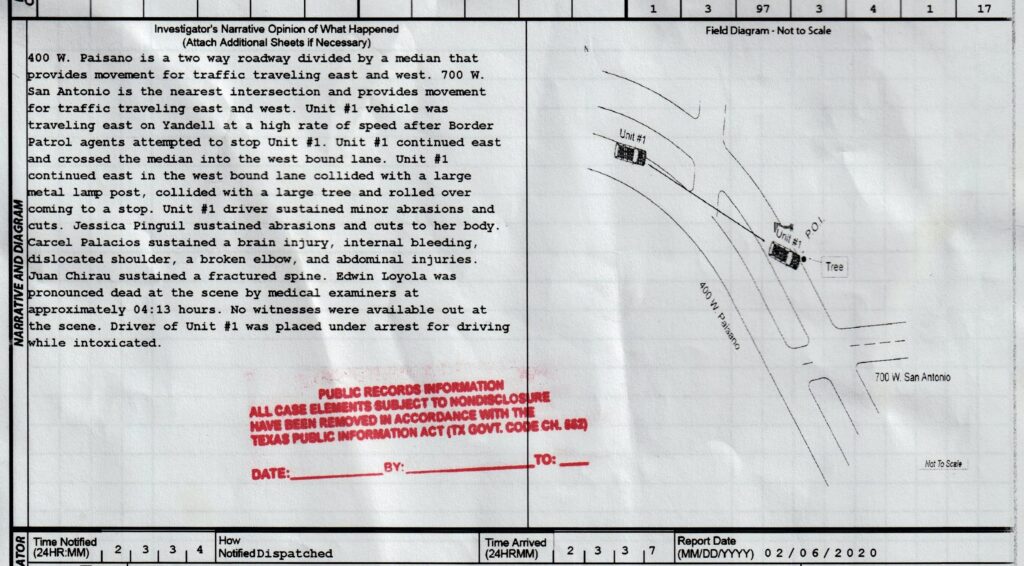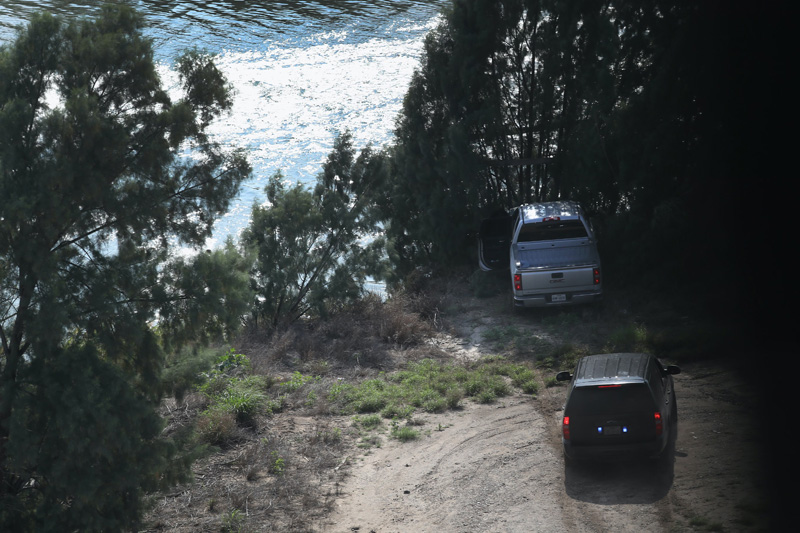By Debbie Nathan for The Intercept_ | February 28 2020, 8:00 a.m.
A few minutes before midnight on January 29, an Ecuadorian man was killed in a car crash near downtown El Paso, Texas, only yards from the U.S.-Mexico border. An Ecuadorian woman was gravely hurt and weeks later is just emerging from a coma. She’s missing part of her skull and half of her body appears to be paralyzed. Stuck in a hospital thousands of miles from her kin, she has had few visitors, but one has been a Border Patrol agent who feels grief-stricken by the accident and believes the Border Patrol played a major role in causing it. The agent recently had an emotional meeting with a family member of the severely injured woman and offered to testify if the family brings a lawsuit.
Police reports say the crash was caused by a drunk driver who picked up the Ecuadorians after they crossed into the U.S. illegally. The driver is said to have been a smuggler who was speeding to evade the Border Patrol, and crashed because he was driving too fast. But the agent says that the chase was improper. It occurred near downtown El Paso on West Paisano Drive, on a section of road so prone to crashes that local law enforcement officers call it a “deadly curve.”
While reporting this story, I witnessed the dangers of the curve firsthand. When I went to inspect the crash site recently, a car barreled around the curve. It went out of control, sparked, flamed, and totaled. A man came out of a nearby apartment and remarked that, just in the past few weeks, he had seen three other crashes in the same spot. A review of local media revealed that one of the crashes killed a man.
El Paso Border Patrol agent Deliris Montañez, 49, contacted The Intercept and described working on January 29 at the Rio Grande near the international border, about a mile from downtown El Paso. Her job was to watch for undocumented crossers and monitor the agency’s radio. Montañez heard another agent on the radio. He was working upriver and said he’d spotted four people who had just crossed into the U.S. and had been picked up by a driver in a car. The car sped up, and the agent started following it in his Border Patrol vehicle. He activated his siren and flashing lights. When that happens, a chase has officially begun.
Montañez, a few blocks downriver, heard the agent on the radio say that he was increasing his speed to follow the car. Then Montañez saw his flashing lights reflecting off of the border fence.
Minutes later, all Border Patrol agents in the area were summoned to the corner of West Paisano Drive and San Antonio Street. The car that had picked up the four people lay upside down and totaled. A police report states that the car had rounded a curve on Paisano — the “deadly curve” — at high speed, and the vehicle jumped a median, collided with a tree and a light post, and rolled over. The driver, Daniel Humberto Castillo, fled but was quickly caught. His breath smelled of alcohol. Castillo said he had picked up the four people farther north on Paisano, where the road fronts the river. Then, Castillo said, he panicked when the Border Patrol started chasing him.

Photo: Debbie Nathan for The Intercept
Inside the wreck were Castillo’s passengers, all Ecuadorians. One, 30-year-old Edwin Leonardo Solis, died at the scene. Of the survivors, Jessica Alexandra Chirau, 27, sustained bruises and sprains. Juan Carlos Chirau, 36, had several fractured vertebrae. Marcela Naomi Palacios, 28, sustained the worst injuries. In addition to fractures of her elbow, spine, and clavicle, she had a lacerated spleen, air and fluid in her lungs, a brain bleed, and brain swelling. She was near death and in a coma. She underwent surgeries at a local hospital and was placed in intensive care. She remains at the hospital.
Montañez was horrified by the carnage. She was assigned to take an injured passenger to an emergency room, and there, she said, “I talked to a policewoman about what I’d heard on the radio. About how the Border Patrol had started chasing.”
The Border Patrol denies having engaged in a chase. The agent who saw the four people cross the river “lost sight” of their vehicle after it sped off, a Customs and Border Protection spokesperson told The Intercept via email. The email further says that the agent “continued eastbound on Paisano to search for [the vehicle],” and by the time the car was located, it was wrecked.
But police reports and statements, as well as the Border Patrol’s own record of vehicle pursuits in the area, raise questions about the agency’s denial of a chase. An El Paso Police Department press release states that the driver was “traveling at a high rate of speed as Border Patrol agents drove towards the vehicle.” A report supporting warrants for driver Castillo’s arrest on intoxicated manslaughter and related charges says that he told police he sped up because “he realized that Border Patrol began chasing him.” Another police report describes Castillo’s vehicle jumping a median before the crash. The report implies that someone witnessed that jump — though it also claims there were no witnesses.
The Border Patrol has a recent history of conducting vehicle chases on Paisano Drive. One, in December 2019, ended in a crash at the same site where the Ecuadorians’ deadly collision would occur just weeks later. The December incident happened on a Tuesday at 7:37 a.m., the start of El Paso’s rush hour. A police report notes that the 17-year-old driver was “evading” a Border Patrol vehicle and lost control.
Local media provided details. One report said that Border Patrol agents saw three suspects climbing a border wall and entering a vehicle. “Agents attempted to stop the vehicle, but the driver fled,” the report continued.
The headline described the attempt as a chase. The vehicle struck a median, the article continued. The police report map indicates it was the same median as the one the Ecuadorians’ car later fatally jumped.
Yet another Border Patrol chase occurred on January 27, two days before the Ecuadorians crashed. Media reports describe agents pursuing a vehicle they’d seen pick up three suspected undocumented migrants. According to reports, the chase that ensued went through a densely populated residential neighborhood and an apartment complex.

Photo: John Moore/Getty Images
“They’re Not Going to Hush Me Up”
No one was hurt in these earlier pursuits. But Border Patrol chases quite often cause injury and death, and they frequently violate contemporary law enforcement practice.
Last year, the Los Angeles Times and ProPublica published an in-depth study about Border Patrol vehicle pursuits that occurred from 2015 to 2018 in border districts in California, Texas, New Mexico, and Arizona. The reporters found 504 chases. At least 250 people were injured; twenty-two died.
The reporters were unable to obtain records from the Border Patrol and had to work with court and media records. They believe their numbers are undercounts. The data they were able to gather showed that in the two years after Donald Trump assumed office, the number of people hurt in pursuit crashes jumped by 42 percent.
Vehicle pursuits were once the norm for U.S. law enforcement agencies. But by the early 1990s, they had caused so much damage, injury, and death — as well as lawsuits against the government — that the Department of Justice narrowed pursuit guidelines.
“Whether or not to engage in a high-speed chase … becomes a question of weighing the danger to the public of the chase itself against the danger to the public of the offender remaining at large,” the DOJ advised. “For anyone other than a violent felon, the balance weighs against the high-speed chase.”
Last December, after Border Patrol agents in El Paso chased some suspected undocumented migrants into a public grade school during a family Christmas program, a local TV station asked CBP how they decide when to do a chase.
“Each situation is determined based on varying factors such as road conditions, severity of offense, threat to the community and many others,” CBP responded. “As the event evolves, we continue to evaluate the situation to determine whether or not the pursuit will continue. The safety of the community is always at the forefront of any decisions made.”
But in the recent crash, Montañez said, the policy was ignored. “The supervisor should have ordered a stop to the pursuit,” she said. “When you back off from your emergency lights, the driver tends to think, ‘Oh, he’s letting me go,’ and slows down. Then the agent follows him normally instead of being on a chase.” On January 29, that back-off order didn’t come, she said. “Maybe the supervisor was busy and not listening to the radio. I don’t know what happened.”
After the crash, Montañez was sometimes assigned Border Patrol guard duty at the Intensive Care Unit bedside of Marcela Palacios. Palacios is perhaps 5 feet tall and is very petite. After almost a month in a coma, now barely conscious and partially paralyzed, she looks like a waxen doll. The only vestige of her former self is the tattoo on her motionless, upper right arm: a polychrome riot of flowers.
Read full article at The Intercept_
https://theintercept.com/2020/02/28/border-patrol-el-paso-texas-car-chase/